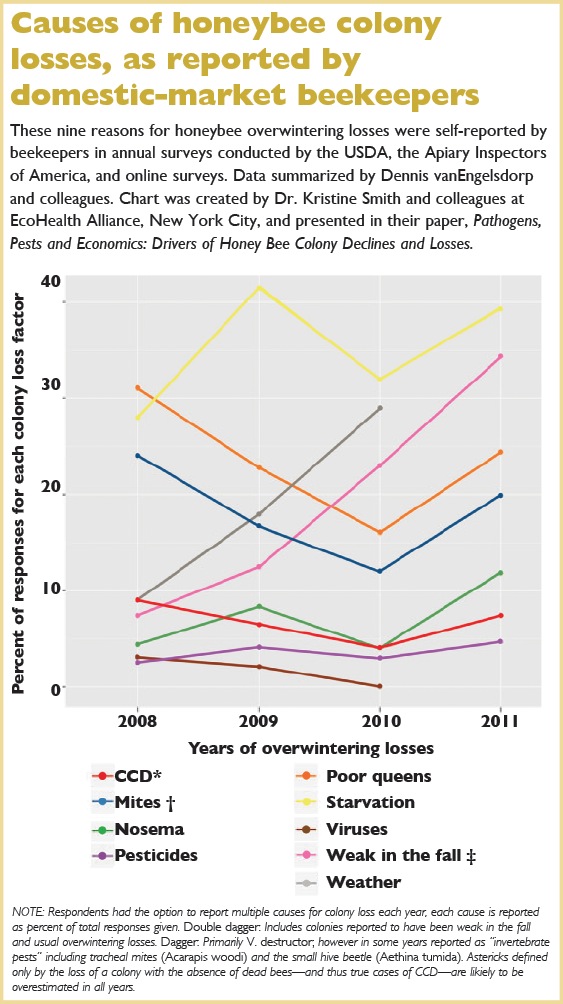In many ways, honeybees are the canaries in the coal mine, the critters that die first when the air gets bad.
For the last several years, people have been in a frenzy over the high mortality of honeybee hives.
Not only are they concerned about bees, but they’re concerned that pollination of food crops will be threatened.
But it’s not one thing in the environment—like methane in the coal mine—that threatens honeybees.
It’s a combination of things that don’t just add together, but multiply. One plus one doesn’t always equal two; it may equal 2,000. That’s called synergism.
Researchers at Pennsylvania State University, including entomologists Drs. Jim and Maryann Frazier and Chris Mullin, have found that, in combination, four commonly used pesticides kill honeybee larvae in the hive.
More concerning is that one of these is chlorothalonil, a fungicide commonly used in fruit and vegetable production.
And even more concerning, in Mullin’s view, is that a supposedly inert chemical—N-methyl-2-pyrrolidone (NMP), commonly used in formulating pesticides—is itself highly toxic to bee larvae.
In a telephone interview with Good Fruit Grower, Mullin said that so-called inert ingredients are widely used, don’t have to be named on pesticide labels used in the formulation, and are often trade secrets that even government agencies don’t disclose.
“There are about a thousand active ingredients that are pesticides,” he said. “There are over 2,000 substances that are classified inert.” These can be used in formulating everything from personal care products to pharmaceutical drugs to pesticides.
He hopes the Penn State research will make the U.S. Environmental Protection Agency more proactive in looking at inert ingredients and the effects of mixtures of pesticides.
Some of the silicone surfactants now being used in pesticide spray tank mixes greatly increase penetration, changing the lethality of the pesticides. It’s a two-edged sword, since a surfactant can reduce the amount of active ingredient that needs to be used, which is usually considered a positive thing.
Bee-havior
The day-to-day behavior of honeybees makes them—and the brood they feed—vulnerable to toxic materials. They fly through air, picking up particles on the hairs of their body—then land and sweep up pollen to carry back to the hive to provide the protein that bee larvae need to develop. What gets into those pollen baskets on their legs is a mixture of things, since pesticides can be in or on the pollen as well as the flowers they visit.
The team’s previous research showed that forager bees bring back to the hive an average of six different pesticides on the pollen they collect. Nurse bees use this pollen to make beebread, which they then feed to honeybee larvae.
Change needed at EPA
The team’s research was published in January in the online science journal PLoS ONE and further publicized in a Penn State University article.
“We found that four of the pesticides most commonly found in beehives kill bee larvae,” Jim Frazier reported in the article. “We also found that the negative effects of these pesticides are sometimes greater when the pesticides occur in combinations within the hive. Since pesticide safety is judged almost entirely on adult honeybee sensitivity to individual pesticides and also does not consider mixtures of pesticides, the risk assessment process that the Environmental Protection Agency uses should be changed.”
Interestingly, however, two of the pesticides studied (fluvalinate and coumaphos) are not crop protection chemicals, but miticides placed in the hives by beekeepers themselves to control Varroa mites.
The mites, which came to the United States about 30 years ago, have had an overwhelmingly negative impact on bees and beekeepers. They feed on and kill bees directly or through the viruses and diseases they carry. They are now thought to play a key role in colony collapse disorder.
The other two pesticides in the study were chlorothalonil (sold under many brand names including Bravo) and chlorpyrifos (sold under many names including Lorsban). Chlorothalonil has been widely used for 50 years because it is broadly effective and diseases do not develop resistance to it.
It is this multisite action that probably makes it more toxic to bees, Mullin said. Among the four pesticides, honeybee larvae were most sensitive to chlorothalonil.
Pesticides may directly poison honeybee larvae or they may indirectly kill them by disrupting the fungi that are essential for nurse bees to process pollen into beebread, Mullin stated in the article.
“Chronic exposure to pesticides during the early life stage of honeybees may contribute to their inadequate nutrition or direct poisoning with a resulting impact on the survival and development of the entire bee brood,” he said.
Mullin’s advice to growers is to avoid applying fungicides during bloom when bees are foraging.
Beekeepers are also attempting to shift away from the miticides they are now using to amitraz (sold as Apivar), a miticide that has, so far, not shown synergistic effects with other chemicals. It has been approved for use in some states under Section 18 permits from the Environmental Protection Agency. •







This is escellent information for fruit growers, especially if the grower practices any type of Integrated Pest Management. We have always sprayed our insecticides at night to allow plwnty of drying time and have only used products that have very low or no toxicity to our bees. We generally keep 40 to 50 hives in our orchard year round and sell the honey they produce. We will now change our spray protocol for fungicides to be sprayed only at night, just as we have done with our insecticides. We have never used any products with chlorothalonil, such as Bravo, and will not int he future. Articles such as this one are of great value to those of us who practice Bio-intensive IPM and are concerned about our bee populations. The good health of our bees located all around the orchard is a testament to this insect and disease management strategy.